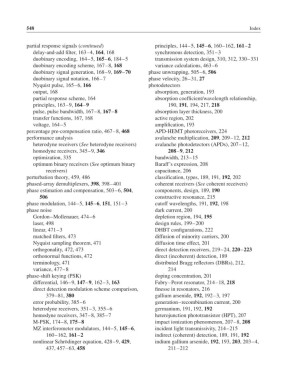Page 567 - Fiber Optic Communications Fund
P. 567
548 Index
partial response signals (continued) principles, 144–5, 145–6, 160–162, 161–2
delay-and-add filter, 163–4, 164, 168 synchronous detection, 351–3
duobinary encoding, 164–5, 165–6, 184–5 transmission system design, 310, 312, 330–331
duobinary encoding scheme, 167–8, 168 variance calculations, 463–6
duobinary signal generation, 168–9, 169–70 phase unwrapping, 505–6, 506
duobinary signal notation, 166–7 phase velocity, 26–31, 27
Nyquist pulse, 165–6, 166 photodetectors
output, 168 absorption, generation, 193
partial response scheme, 164 absorption coefficient/wavelength relationship,
principles, 163–9, 164–9 190, 191, 194, 217, 218
pulse, pulse bandwidth, 167–8, 167–8 absorption layer thickness, 200
transfer functions, 167, 168 active region, 202
voltage, 164–5 amplification, 193
percentage pre-compensation ratio, 467–8, 468 APD-HEMT photoreceivers, 224
performance analysis avalanche multiplication, 209, 209–12, 212
heterodyne receivers (See heterodyne receivers) avalanche photodetectors (APDs), 207–12,
homodyne receivers, 345–9, 346 208–9, 212
optimization, 335 bandwidth, 213–15
optimum binary receivers (See optimum binary Baraff’s expression, 208
receivers) capacitance, 206
perturbation theory, 459, 486 classification, types, 189, 191, 192, 202
phased-array demultiplexers, 398, 398–401 coherent receivers (See coherent receivers)
phase estimation and compensation, 503–6, 504, components, design, 189, 190
506 constructive resonance, 215
phase modulation, 144–5, 145–6, 151, 151–3 cutoff wavelengths, 191, 192, 198
phase noise dark current, 200
Gordon–Mollenauer, 474–6 depletion region, 194, 195
laser, 498 design rules, 199–200
linear, 471–3 DHBT configurations, 222
matched filters, 473 diffusion of minority carriers, 200
Nyquist sampling theorem, 471 diffusion time effect, 201
orthogonality, 472, 473 direct detection receivers, 219–24, 220–223
orthonormal functions, 472 direct (incoherent) detection, 189
terminology, 471 distributed Bragg reflectors (DBRs), 212,
variance, 477–8 214
phase-shift keying (PSK) doping concentration, 201
differential, 146–9, 147–9, 162–3, 163 Fabry–Perot resonator, 214–18, 218
direct detection modulation scheme comparison, finesse in resonators, 216
379–81, 380 gallium arsenide, 192, 192–3, 197
error probability, 385–6 generation–recombination current, 200
heterodyne receivers, 351–3, 355–6 germanium, 191, 192, 192
homodyne receivers, 347–8, 385–7 heterojunction phototransistor (HPT), 207
M-PSK, 174–8, 175–8 impact ionization phenomenon, 207–8, 208
MZ interferometer modulators, 144–5, 145–6, incident light transmissivity, 214–215
160–162, 161–2 indirect (coherent) detection, 189, 191, 192
nonlinear Schrödinger equation, 428–9, 429, indium gallium arsenide, 192, 193, 203, 203–4,
437, 457–63, 458 211–212

